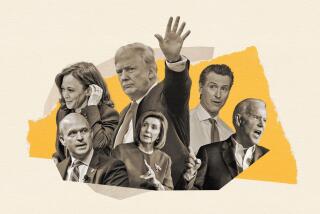U.S. Greens Draft Party Platform
NEW YORK — A variety of activists on environmental, energy and social issues are drafting a political program to create a national Greens political party as early as next year, organizers say.
Modeled after Greens parties in Europe, the party would seek to build nationwide policy on environmental and social issues that it says get inadequate attention from the Republican and Democratic parties.
But Greens planners are divided on whether their new party should make an early run at national office, traditionally almost impossible for American third parties, or first concentrate its efforts on capturing local and state offices.
The Green Committees of Correspondence, a federation of about 200 groups nationwide, mailed a 36-page list of proposed stands to 3,500 people this fall, said Jim Richmond, coordinator for the group’s national clearinghouse in Kansas City, Mo.
The Greens, as they call themselves, plan to ratify the final platform at a September, 1990 meeting in Boulder, Colo. Meanwhile, the 200 groups are planning regional meetings to debate stands on 19 issues, including land use, water, social justice, energy, health, education and finance.
“It’s activists and just regular folks of all stripes who are concerned what direction this planet is headed in,” Richmond said of the 4-year-old group.
Born from the remnants of Vietnam war protesters and the environmental and anti-nuclear movements that appeared in the 1960s, the largely white, well-educated Greens are far behind European parties with the same name, said writer Brian Tokar, an organizer.
Tokar, a toxic chemical and energy consultant, said the U.S. and Canadian Greens movements have been held back by the political systems in each country.
Many European countries use a system of proportional representation in parliamentary elections, which allows even small parties to get into Parliament if they win a minor percentage of the vote nationwide. Fringe parties have a harder time under the U.S. and Canadian systems, which elect representatives by district.
European Greens, united by polluted rivers and forests dying from acid rain, won 30 seats this year in the 475-seat European Parliament.
West Germany has the largest Greens contingent--42 of the 519 federal parliamentarians. They also are in the legislatures of Belgium, Italy, Austria and the Netherlands.
“European Greens are basically defined by four pillars,” said Tokar. Those are: ecology, social responsibility, community-oriented democracy and the nonviolent movement-- where they are often seen demonstrating against nuclear missiles.
“Greens in this country strongly embrace those principles, but we’ve sought to elaborate on them,” Tokar said from his Plainfield, Vt., home.
The draft political program emphasizes:
Creating environmental and economic policy that is not harmful to the United States or the world.
Decentralization, bringing decision-making back from the federal and state levels to local communities and the people whose lives it affects.
* An end to oppression based on race, sex and economics.
* Focusing on how the nation can work in harmony with the world community and nature.
“The centerpiece is to rethink our relationship to the Earth,” said John Rensenbrink, professor of political science at Bowdoin College in Maine and another organizer.
Issues such as the destruction of the Earth’s protecting ozone layer are related to any number of government decisions in areas of energy, health, education and finance, he said.
A handful of people guide the group, which opposes the concept of hierarchy. Decisions are made by committees of representatives, and a national leadership probably will not be chosen until the U.S. Greens jump into politics, he said.
As they continue to organize, Greens are forming clubs at universities and have state organizations in Michigan, California, Georgia, Maine, Wisconsin and Massachusetts, Rensenbrink said.
However, the would-be political party is hindered by divisions on several issues.
* Greens’ principles call for restraining capitalism where it harms the environment or community life. But conservative Greens, who joined to fight pollution, believe in a national economy driven by relatively free capitalism, Tokar said.
* Greens members debating the proposed national platform are leaning toward a pro-choice abortion stance--but some members are anti-abortion, said Richmond and Rensenbrink.
* Some Greens want a national party to organize on the state and local levels, while others want to field a national candidate, Greens leaders said.
While the Greens are closest ideologically to liberal Democrats, Democratic National Committee spokeswoman Ginny Terzano said her party is not worried.
“The bottom line is that the Democratic Party has a strong platform,” she said, adding that it includes environmental and human rights issues.
More to Read
Sign up for Essential California
The most important California stories and recommendations in your inbox every morning.
You may occasionally receive promotional content from the Los Angeles Times.










